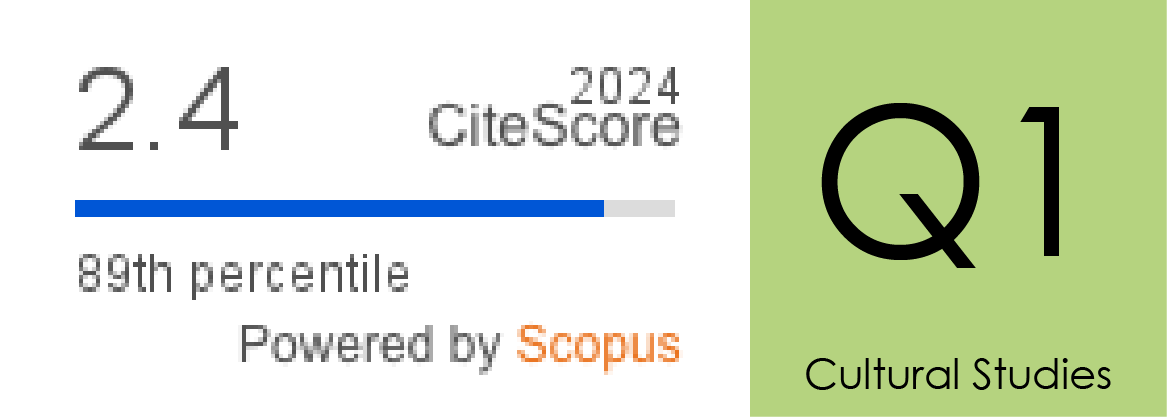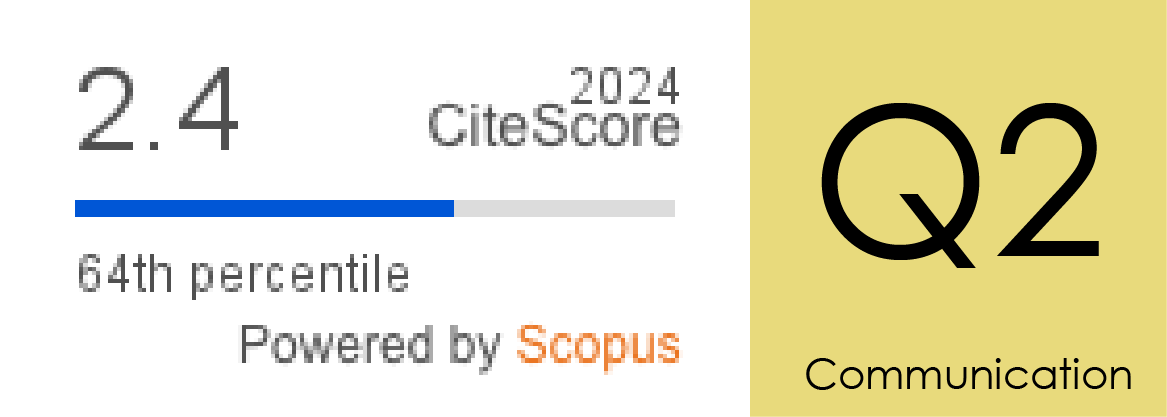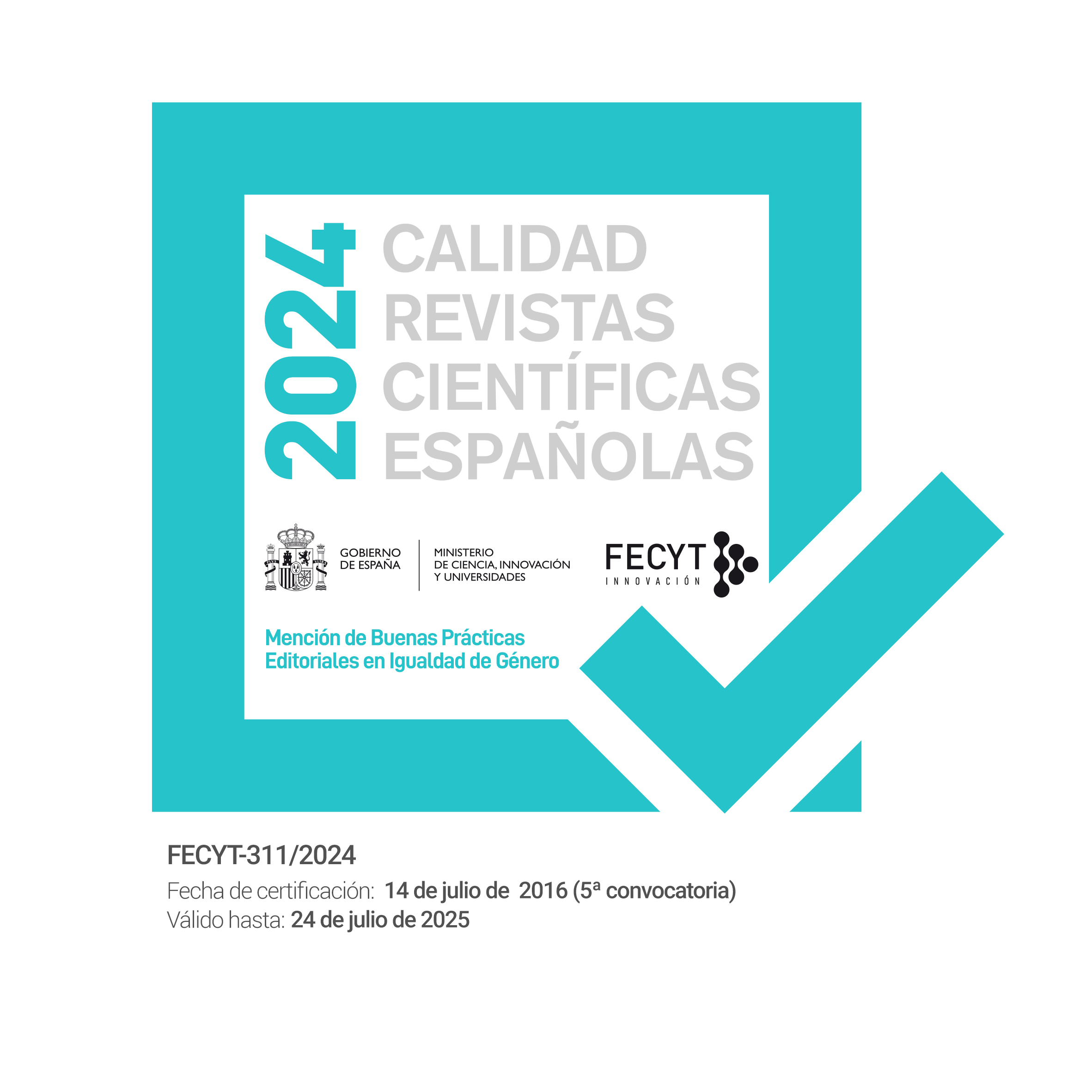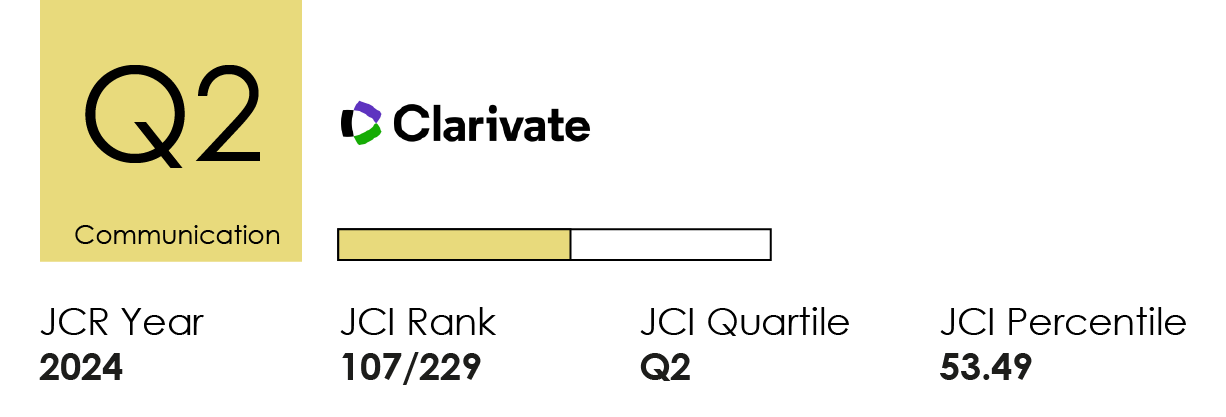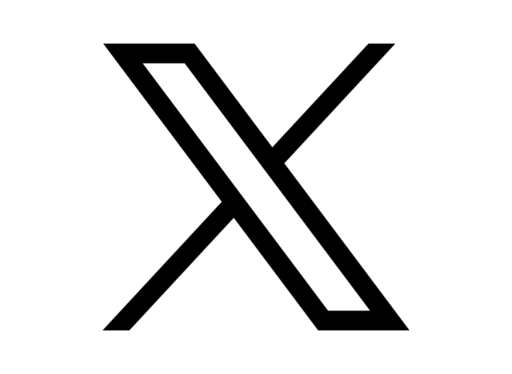Entre la saturación y el refugio: características de la evitación informativa de jóvenes en América Latina
DOI:
https://doi.org/10.14198/MEDCOM.30555Palabras clave:
Consumo emergente, Consumo informativo, Estudiantes universitarios, Evitación de noticias, NoticiasResumen
Propósito. Este estudio describe las características de la
evitación de noticias entre jóvenes estudiantes de
Comunicación en universidades latinoamericanas.
Metodología. Se aplicó un enfoque cualitativo y
exploratorio mediante 96 grupos focales realizados entre
febrero y diciembre de 2023 en 37 universidades
públicas y privadas de Argentina, Chile, Colombia,
Ecuador, México, Perú, Uruguay y Venezuela, con
estudiantes de pregrado seleccionados por conveniencia.
Resultados y conclusiones. Se constató que la
evitación es principalmente selectiva, vinculada con
temas como pandemia, noticias policiales, conflictos
políticos y guerras. La negatividad y la sobrecarga
informativa generan emociones como ansiedad y
angustia, llevando a los jóvenes a desarrollar estrategias
de refugio, entre ellas el uso de redes sociales para
contenidos de entretenimiento, la configuración
algorítmica para silenciar información y la desconexión
temporal de los medios. Estas prácticas inciden en la
forma en que perciben la calidad y relevancia del
periodismo. Aportación original. El estudio aporta
evidencia inédita sobre la evitación noticiosa en jóvenes
latinoamericanos, un segmento poco explorado pese a
su rol futuro como profesionales de la comunicación. Sus
hallazgos ayudan a comprender cómo los medios
pueden reconectar con audiencias jóvenes, y contribuyen
al debate académico sobre la plataformización del
consumo informativo y sus efectos en la relación entre
medios, política y sociedad.
Citas
Aharoni, Tali, Kligler-Vilenchik, Neta, & Tenenboim-Weinblatt, Keren (2020). Be Less of a Slave to the News: A Texto-Material Perspective on News Avoidance among Young Adults. Journalism Studies, 22(1), 42-59. https://doi.org/10.1080/1461670x.2020.1852885
Aimetta, Freda, y Peret, Maximiliano (2025). Ya no te dan ganas de leerlo: Las redes sociales como puerta de entrada a las noticias. Intersecciones En Comunicación, 1(19). https://doi.org/10.51385/q5625c18
Agarwal, Naresh (2023). Information Behavior Research in the twenty-first century: The journey so far. Informatio, 28(1), 97–146. https://doi.org/10.35643/info.28.1.5
Albarello, Francisco (2020). De la hegemonía al nicho: desplazamiento de medios tradicionales en rutinas informativas de un grupo de universitarios argentinos. Dixit, 32, 46–60. https://doi.org/10.22235/D.VI32.1946
Albarello, Francisco (ed.) (2022). Mutaciones. Hábitos de información y estudio de jóvenes en universidades argentinas. UNR Editora.
Albarello, Francisco (2024). Investigar en Red: una experiencia de inteligencia colectiva en Latinoamérica. Chasqui. Revista Latinoamericana de Comunicación, 1(155). https://doi.org/10.16921/chasqui.v1i155.4990
Andersen, Kim, Toff, Benjamin, & Ytre-Arne, Brita (2024a). Introduction: What We (Don’t) Know About News Avoidance. Journalism Studies, 25(12), 1367–1384. https://doi.org/10.1080/1461670X.2024.2393131
Andersen, Kim, Shehata, Adam, Skovsgaard, Morten, & Strömbäck, Jesper (2024b). Selective News Avoidance: Consistency and Temporality. Communication Research. https://doi.org/10.1177/00936502231221689
Andrada Sola, Pablo, Arri, Francisco, García Luna, Ana Laura, y Paredes, Graciela (2025). El uso de Instagram en el consumo informativo de los estudiantes de Comunicación en América Latina. La Trama de La Comunicación, 28(02), 194–230. https://doi.org/10.35305/lt.v28i02.879
Avendaño, William R, Luna, Henry O, & Rueda, Gerson (2021). Virtual education in times of COVID-19: perceptions of university students. Formación universitaria, 14(5), 119-128. https://dx.doi.org/10.4067/S0718-50062021000500119
Bergström, Annika, & Jervelycke Belfrage, Maria (2018). News in social media: Incidental consumption and the role of opinion leaders. Digital Journalism, 6(5), 583–598. https://doi.org/10.1080/21670811.2018.1423625
Boczkowski, Pablo (2022). Abundancia: La experiencia de vivir en un mundo pleno de información. UNSAM Edita, Universidad Nacional de San Martín.
Boczkowski, Pablo, y Mitchelstein, Eugenia (2021). The digital environment: How we live, learn, work, and play now. The MIT Press. https://doi.org/10.7551/mitpress/13602.001.0001
Boczkowski, Pablo, Mitchelstein, Eugenia, y Matassi, Mora (2018). “News comes across when I’m in a moment of leisure”: Understanding the practices of incidental news consumption on social media. New Media & Society, 20(10), 3523-3539. https://doi.org/10.1177/1461444817750396
Bordón, Esteban, Nieva Agreda, M. de los Ángeles, Saya, Alejandro, y Silvestre, Gustavo (2025). Desarrollo de competencias mediáticas para el consumo crítico de información en estudiantes de Comunicación y Periodismo en Latinoamérica. AdComunica, (29), 119–144. https://doi.org/10.6035/adcomunica.8515
Bustamante, Guillermo, Jaramillo-Castro, Oscar, y Piña-Araya, Rommel (2019). Competencias mediáticas para periodistas en tiempos de infoxicación. Latin American Journal of International Affairs, 9(2), 84-92. http://www.lajia.net/lajia/article/view/92
Braun, Victoria, y Clarke, Virginia (2014). Análisis temático. En Teo, T. (ed.), Enciclopedia de Psicología Crítica (pp. 1947-1952). Springer.
Bryman, Alan (2012). Social research methods (4th ed.). Oxford University Press.
Canavilhas, João, y Di Fátima, Branco (2025). Reporteros del futuro: consumo de noticias entre estudiantes de periodismo en Portugal. Doxa Comunicación. Revista Interdisciplinar de Estudios de Comunicación y Ciencias Sociales, 40, 305-319. https://doi.org/10.31921/doxacom.n40a2392
Ceballos-del-Cid, Yaiza, Gómez-Calderón, Bernardo, y Córdoba-Cabús, Alba (2025). Redes sociales y hábitos de consumo informativo de los jóvenes españoles: un análisis diacrónico (2021-2023). Revista Mediterránea de Comunicación, 16(1), e28010. https://doi.org/10.14198/MEDCOM.28010
Collier, Jessica, Dunaway, Johanna, & Stroud, Natalie (2021). Pathways to Deeper News Engagement: Factors Influencing Click Behaviors on News Sites. Journal of Computer-Mediated Communication, 26(5), 265–283. https://doi.org/10.1093/jcmc/zmab009
Couraceiro, Paulo, & Paisana, Miguel (2024). Da Personalização Algorítmica à Mediação Jornalística: Mudanças nas Preferências dos Jovens Portugueses no Consumo de Notícias Online. Media & Jornalismo, 24(45), e4504. https://doi.org/10.14195/2183-5462_45_4
Creswell, John, & Creswell, David (2017). Research design: Qualitative, quantitative, and mixed methods approaches. Sage publications.
Damstra, Alyt, Vliegenthart, Rens, Boomgaarden, Hajo, Glüer, Kathrin, Lindgren, Elina, Strömbäck, Jesper, & Tsfati, Yariv (2023). Knowledge and the News: An Investigation of the Relation Between News Use, News Avoidance, and the Presence of (Mis)beliefs. International Journal of Press/Politics, 28(1), 29–48. https://doi.org/10.1177/19401612211031457
Díaz, Eliseo (2025). Juventudes, usos y consumos de noticias políticas. Sistematización bibliográfica latinoamericana. Investigación & Desarrollo, 33(1), 187–217. https://doi.org/10.14482/indes.33.01.720.003
Dvir-Gvirsman, Shira (2022). Understanding news engagement on social media: A media repertoire approach. New Media and Society, 24(8), 1791–1812. https://doi.org/10.1177/1461444820961349
Edgerly, Stephanie, Vraga, Emily, Bode, Leticia, Thorson, Kjerstin, & Thorson, Esther (2018). New Media, New Relationship to Participation? A Closer Look at Youth News Repertoires and Political Participation. Journalism and Mass Communication Quarterly, 95(1), 192–212. https://doi.org/10.1177/1077699017706928
Edgerly, Stephanie (2022). The head and heart of news avoidance: How attitudes about the news media relate to levels of news consumption. Journalism, 23(9), 1828–1845. https://doi.org/10.1177/14648849211012922
Edgerly, Stephanie (2023). Avoiding News is Hard Work, or is it? A Closer Look at the Work of News Avoidance among Frequent and Infrequent Consumers of News. Journalism Studies, 1-19. https://doi.org/10.1080/1461670X.2023.2293834
Escudero, Camila (2020). El análisis temático como herramienta de investigación en el área de la Comunicación Social: contribuciones y limitaciones. La Trama de la Comunicación, 24(2), 89-100. https://doi.org/10.35305/lt.v24i2.746
Flick, Uwe (2014). Introducción a la investigación cualitativa. Sage Publications.
Gorski, Lea, & Thomas, Fabián (2022). Staying Tuned or Tuning Out? A Longitudinal Analysis of News-Avoiders on the Micro and Macro-Level. Communication Research, 49(7), 942–965. https://doi.org/10.1177/00936502211025907
Gorski, Lea (2023). Uninterested, disenchanted, or overwhelmed? An analysis of motives behind intentional and unintentional news avoidance. Communications, 48(4), 563–587. https://doi.org/10.1515/commun-2021-0084
Goyanes, Manuel, Ardèvol-Abreu, Alberto, y Gil de Zúñiga, Homero (2023). Antecedents of News Avoidance: Competing Effects of Political Interest, News Overload, Trust in News Media, and “News Finds Me” Perception. Digital Journalism, 11(1), 1–18. https://doi.org/10.1080/21670811.2021.1990097
Gran, Anne-Britt, Booth, Peter, & Bucher, Taina (2020). To be or not to be algorithm aware: a question of a new digital divide? Information, Communication & Society, 24(12), 1779–1796. https://doi.org/10.1080/1369118X.2020.1736124
Hagar, Nick, & Diakopoulos, Nicholas (2023). Algorithmic indifference: The dearth of news recommendations on TikTok. New Media & Society, 0(0). https://doi.org/10.1177/14614448231192964
Hameleers, Michael & Meer, Toni (2023). With time comes trust? The development of misinformation perceptions related to COVID-19 over a six-month period: Evidence from a five-wave panel survey study in the Netherlands. Communications, 50(2), 213-235. https://doi.org/10.1515/commun-2023-0010
Hendrickx, Jonathan (2024). ‘Normal news is boring’: How young adults encounter and experience news on Instagram and TikTok. New Media & Society, 0(0). https://doi.org/10.1177/14614448241255955
Hernández, Roberto, Fernández, Carlos, & Baptista, Pilar (2014). Metodología de la investigación. Mc Graw-Hill.
Itzkowitz, Aliya, Whitelaw, Ben, Donald, Daisy, Montagu, George, Gilbert, Jeremy, Germuska, Joe, Lambertini, Lamberto, Fainman-Adelman, Liat, & Ha, Tran (2024). Next Gen News: Understanding the audiences of 2030. https://www.next-gen-news.com/
Kalogeropoulos, Antonis, Toff, Benjamin, & Fletcher, Richard (2024). The Watchdog Press in the Doghouse: A Comparative Study of Attitudes about Accountability Journalism, Trust in News, and News Avoidance. International Journal of Press/Politics, 29(2), 485–506. https://doi.org/10.1177/19401612221112572
Karlsen, Rune, Beyer, Audun, & Steen-Johnsen, Kari (2020). Do High-Choice Media Environments Facilitate News Avoidance? A Longitudinal Study 1997–2016. Journal of Broadcasting and Electronic Media, 64(5), 794–814. https://doi.org/10.1080/08838151.2020.1835428
Kenya, Harry, & Rofil, Lily (2023). News consumption behaviours of Jakarta youth during the COVID-19 pandemic. AIP Conference Proceedings, 2594 (1). https://doi.org/10.1063/5.0123534
Kormelink, Tim, & Klein Gunnewiek, Anne (2022). From “Far Away” to “Shock” to “Fatigue”to “Back to Normal”: How Young People Experienced News During the First Wave of the COVID-19 Pandemic. Journalism Studies, 23(5–6), 669–686. https://doi.org/10.1080/1461670X.2021.1932560
Lazcano-Peña, Daniela, Gálvez-Pereira, María Paz, y Zuleta-Cavalli, Rafaella (2021). Imaginarios sobre periodismo en Chile antes y después del estallido social. Una mirada desde futuros profesionales. Avatares de la Comunicación y la Cultura, (21). https://doi.org/10.62174/avatares.2021.6248
Lee, Francis, Chan, Michael, Chen, Hsuan, Nielsen, Rasmus, & Fletcher, Richard (2019). Consumptive News Feed Curation on Social Media as Proactive Personalization: A Study of Six East Asian Markets. Journalism Studies, 20(15), 2277–2292. Intencional. https://doi.org/10.1080/1461670X.2019.1586567
Londoño-Pardo, Óscar, Arbelaez, María Paula, y Mateus, Julio-Cesar (2025). Creencias, actitudes y comportamientos de los estudiantes universitarios de la Comunidad Andina ante la desinformación. Cuadernos.Info, (60), 168–189. https://doi.org/10.7764/cdi.60.86100
Mellado, Claudia, y Cruz, Alexis (2025). Informe 2025. Consumo de Noticias y Evaluación del Periodismo en Chile. Valparaíso: Pontificia Universidad Católica de Valparaíso. https://www.noticiasyperiodismo.cl/
Nettlefold, Jocelyn, & Pecl, Gretta (2020). Engaged Journalism and Climate Change: Lessons From an Audience-led, Locally Focused Australian Collaboration. Journalism Practice, 16(1), 19–34. https://doi.org/10.1080/17512786.2020.1798272
Newman, Nic, Fletcher, Richard, Eddy, Kirsten, Robertson, Graig, & Kleis Nielsen, Rasmus (2023). Digital News Report 2023. Reuters Institute for the Study of Journalism. https://reutersinstitute.politics.ox.ac.uk/digital-news-report/2023
Newman, Nic, Fletcher, Richard, Eddy, Kirsten, Robertson, Graig, & Kleis Nielsen, Rasmus (2025). Digital News Report. Reuters Institute for the Study of Journalism. https://reutersinstitute.politics.ox.ac.uk/es/digital-news-report/2025
Nguyen, An, Glück, Antje, & Jackson, Daniel (2023). The up-down-up pandemic news experience: A mixed-method approach to its negative and positive effects on psychological wellbeing. Journalism, 24(12), 2687–2704. https://doi.org/10.1177/14648849221135137
Ohme, Jakov, Araujo, Theo, Zarouali, Brahim, & de Vreese, Claes (2022). Frequencies, Drivers, and Solutions to News Non-Attendance: Investigating Differences Between Low News Usage and News (Topic) Avoidance with Conversational Agents. Journalism Studies, 23(12), 1510–1530. https://doi.org/10.1080/1461670X.2022.2102533
Overgaard, Christian (2023). Mitigating the consequences of negative news: How constructive journalism enhances self-efficacy and news credibility. Journalism, 24(7), 1424–1441. https://doi.org/10.1177/14648849211062738
Palmer, Ruth & Toff, Benjamin (2020). What Does It Take to Sustain a News Habit? The Role of Civic Duty Norms and a Connection to a “News Community” Among News Avoiders in the UK and Spain. In International Journal of Communication (14). https://ijoc.org/index.php/ijoc/article/view/12252
Palmer, Ruth, Toff, Benjamin, & Nielsen, Rasmus (2020). “The Media Covers Up a Lot of Things”: Watchdog Ideals Meet Folk Theories of Journalism. Journalism Studies, 21(14), 1973–1989. https://doi.org/10.1080/1461670X.2020.1808516
Palmer, Ruth, & Toff, Benjamin (2022). Neither Absent nor Ambient: Incidental News Exposure From the Perspective of News Avoiders in the UK, United States, and Spain. The International Journal of Press/Politics, 29(3), 755-773. https://doi.org/10.1177/19401612221103144
Palmer, Ruth, Toff, Benjamin, & Nielsen, Rasmus (2023). Examining Assumptions Around How News Avoidance Gets Defined: The Importance of Overall News Consumption, Intention, and Structural Inequalities. Journalism Studies, 24(6), 697–714. https://doi.org/10.1080/1461670X.2023.2183058
Palmer, Ruth, & Edgerly, Stephanie (2024a). How Journalists Perceive News Avoidance: Reactions and Solutions to the Missing Audience as Boundary Work. Journalism Studies, 25(12), 1555–1572. https://doi.org/10.1080/1461670X.2024.2345672
Palmer, Ruth, & Edgerly, Stephanie (2024b). “Because the News is Depressing as Hell”: Journalists’ Explanations of News Avoidance. Digital Journalism, 1–19. https://doi.org/10.1080/21670811.2024.2351523
Park, Sora, & Lee, Jee (2023). Incidental News Exposure on Facebook and Its Relation to Trust in News. Social media + Society, 9(1), 205630512311588. https://doi.org/10.1177/20563051231158823
Patton, Michael (2015). Qualitative Research & Evaluation Methods. SAGE
Pedelaborde, Paula, y Silvestre Luengo, Gustavo (2024). Las redes sociales como consumo emergente para acceder a la información. Anuario de la Facultad de Ciencias Humanas. Nueva Época, 20 (20), 3- 10. https://repo.unlpam.edu.ar/handle/unlpam/9310
Pedelaborde, Paula, y Beneitez, María Elena (2025). Jóvenes de La Plata y consumos emergentes: las múltiples estrategias para estar al tanto de lo que les interesa. Question/Cuestión, 3(80), e990. https://doi.org/10.24215/16696581e990
Peña y Lillo, Macarena, & Guzmán, Pablo (2022). Búsqueda, escaneo y evitación de información sobre COVID-19 en Chile. Cuadernos. info, (53), 184-204. https://dx.doi.org/10.7764/cdi.53.47775
Pereyra, Melina, y Cane, Julieta (2024). “¿Es o no es mentira?” Testimonios de estudiantes de Comunicación y Periodismo acerca de la Inteligencia Artificial Generativa y el consumo de noticias. Question/Cuestión, 3(79), e955. https://doi.org/10.24215/16696581e955
Peret, Maximiliano, Casado, Nicolás, y Magallanes, Sergio (2022). Mientras miro las nuevas olas: consumos emergentes en el ecosistema digital y WhatsApp como fuente de información. En Albarello, F. (ed.), Mutaciones. Hábitos de información y estudio de jóvenes en universidades argentinas (pp. 229-245). UNR Editora.
Pérez Altable Laura, Okan Yasmina, Lelonkiewicz Jaroslaw, & Salvador-Mata Bertran (2024). Informe de recerca: Evitació de notícies en població jove resident a Catalunya: variables predictores i línies d’actuació. Universitat Pompeu Fabra. Càtedra Futurs de la Comunicació. http://hdl.handle.net/10230/68986
Reguillo, Rossana (Coord.) (2010). Los jóvenes en México. Fondo de Cultura Económica / Consejo Nacional para la Cultura y las Artes (CONACULTA).
Reiss, Michael (2023). Dissecting Non-Use of Online News–Systematic Evidence from Combining Tracking and Automated Text Classification. Digital Journalism, 11(2), 363–383. https://doi.org/10.1080/21670811.2022.2105243
Rosa Alejandro, Miguel (2024). Hábitos de consumo noticioso de la Generación Z, estudio de caso: estudiantes de Comunicación Social de República Dominicana y Puerto Rico. Universidad Complutense de Madrid. http://hdl.handle.net/20.500.14352/99245
Rost, Alejandro (2022). Cómo se informa el estudiantado de Comunicación y carreras afines en la Argentina. En Albarello, F. (ed.), Mutaciones. Hábitos de información y estudio de jóvenes en universidades argentinas. UNR Editora, (pp. 133-144).
Salaverría, Ramón, Bachmann, Ingrid y Magallón Rosa, Raúl (2024). Desinformación y confianza en los medios: propuestas de actuación. index.Comunicación, 14(2), 13–32. https://doi.org/10.62008/ixc/14/02Yconfi
Serrano Puche, Javier, Fernández, Carmen, & Rodríguez-Virgili, Jordi (2018). Información política y exposición incidental en las redes sociales: un análisis de Argentina, Chile, España y México. Doxa Comunicación. Revista Interdisciplinar de Estudios de Comunicación y Ciencias Sociales, 27, 19–42. https://doi.org/10.31921/doxacom.n27a1
Setianto, Yearry, & Praceka, Puspita (2023). One Year Later, Why Are People Still Avoiding COVID-19 News?: Understanding Predictors of News Avoidance in Indonesia. Jurnal Komunikasi: Malaysian Journal of Communication, 39(3), 60–80. https://doi.org/10.17576/JKMJC-2023-3903-04
Shehata, Adam (2016). News Habits Among Adolescents: The Influence of Family Communication on Adolescents’ News Media Use—Evidence From a Three-Wave Panel Study. Mass Communication and Society, 19(6), 758–781. https://doi.org/10.1080/15205436.2016.1199705
Siles, Ignacio, Gómez‑Cruz, Edgar, & Ricaurte, Paola (2022). Toward a popular theory of algorithms. Popular Communication, 21(1), 57–70. https://doi.org/10.1080/15405702.2022.2103140
Siles-Pavón, Alejandra, Quintana, Mariel, & Díaz, Enrique Antonio (2022). El fin de la inocencia: las y los estudiantes de Comunicación y Periodismo ante las fake news. En: Albarello, F. (ed.), Mutaciones. Hábitos de información y estudio de jóvenes en universidades argentinas (pp. 247-273). UNR Editora.
Sibrian, Nairbis, Alfaro, Amaranta, & Núñez, Juan Carlos (2024a). Validación de instrumento sobre exposición a discursos de odio de comunidades migrantes en el ecosistema mediático chileno: resultados preliminares. Revista Latina de Comunicación Social, (82), 1–23. https://doi.org/10.4185/rlcs-2024-2226
Sibrian Díaz, Nairbis, Alfaro, Amaranta, Núñez, Juan Carlos, y Zúñiga Rodríguez, Vanessa (2024b). Evitación mediática en respuesta al ciberodio hacia personas migrantes en Chile. index.comunicación, 14(2), 83-108. https://doi.org/10.62008/ixc/14/02Evitac
Schäfer, Svenja, Aaldering, Loes, & Lecheler, Sophie (2023). “Give Me a Break!” Prevalence and Predictors of Intentional News Avoidance During the COVID-19 Pandemic. Mass Communication and Society, 26(4), 671–694. https://doi.org/10.1080/15205436.2022.2125406
Schiavinato, Nadia Soledad, & Masi, Alejandra (2025). Aportes de la formación universitaria en Periodismo y Comunicación Social a la construcción del sentido crítico de estudiantes argentinos. RAES - Revista Argentina De Educación Superior, (30), 186-200. https://revistas.untref.edu.ar/index.php/raes/article/view/2137
Schrøder, Kim, & Ørsten, Mark (2016). The nature of news avoidance in a digital world. In Reuters Digital News Report 2016. Reuters Institute for the Study of Journalism. https://www.digitalnewsreport.org/essays/2016/nature-news-avoidance-digital-world/
Skovsgaard, Morten, & Andersen, Kim (2020). Conceptualizing News Avoidance: Towards a Shared Understanding of Different Causes and Potential Solutions. Journalism Studies, 21(4), 459–476. https://doi.org/10.1080/1461670X.2019.1686410
Skovsgaard, Morten, & Andersen, Kim (2022). News avoidance. In The SAGE encyclopedia of journalism, SAGE Publications, Inc. https://doi.org/10.4135/9781544391199
Statista (2025). Plataforma global de datos, Higher education in Latin America - Statistics & Facts https://www.statista.com/topics/13407/higher-education-in-latin-america/#topicOverview
Sued, Gabriela (2022). Culturas algorítmicas: conceptos y métodos para su estudio social. Revista Mexicana de Ciencias Políticas y Sociales, 67(246), 43–73. https://doi.org/10.22201/fcpys.2448492xe.2022.246.7842
Tandoc, Edson, & Kim, Hye (2023). Avoiding real news, believing in fake news? Investigating pathways from information overload to misbelief. Journalism, 24(6), 1174–1192. https://doi.org/10.1177/14648849221090744
Taneja, Harsh, Webster, James, Malthouse, Edward, & Ksiazek, Thomas (2012). Media consumption across platforms: Identifying user-defined repertoires. New Media & Society, 14(6), 951-968. https://doi.org/10.1177/1461444811436146
Thorson, Kjerstin, & Wells, Chris (2016). Curated Flows: A Framework for Mapping Media Exposure in the Digital Age. Communication Theory, 26(3), 309–328. https://doi.org/10.1111/comt.12087
Toff, Benjamin, & Kalogeropoulos, Antonis (2020). All the news That’s fit to ignore: How the information environment does and does not shape news avoidance. Public Opinion Quarterly, 84(S1), 366–390. https://doi.org/10.1093/poq/nfaa016
Toledo, Edgardo, y Comba, Silvana (2025). Prácticas emergentes de consumos informativos en jóvenes. RevCom, (16), e086. https://doi.org/10.24215/24517836e086
UNESCO, Instituto Internacional para la educación superior de América Latina y el Caribe (2025). La educación superior en América Latina y el Caribe: avances y retos; documentos de apoyo para la CRES+5, documento de reunión ED/HE/IESALC/IP/2025/49. https://unesdoc.unesco.org/ark:/48223/pf0000392578?posInSet=1&queryId=N-EXPLORE-5405ba1f-4858-4dfc-b4ce-333a8938c651
Vandenplas, Ruben, Truyens, Pauljan, Vis, S, & Picone, Ike (2021). Tuning Out the News. A Cross-Media Perspective on News Avoidance Practices of Young News Users in Flanders During the COVID-19 Pandemic. Journalism Studies, 22(16), 2197–2217. https://doi.org/10.1080/1461670X.2021.1990788
Van Dijck, José (2020). Seeing the forest for the trees: Visualizing platformization and its governance. New Media & Society, 23(9), 2801-2819. https://doi.org/10.1177/1461444820940293
Villi, Mikko, Aharoni, Tali, Tenenboim-Weinblatt, Keren, Boczkowski, Pablo, Hayashi, Kaori, Mitchelstein, Eugenia, Tanaka, Akira, & Kligler-Vilenchik, Neta (2021). Taking a Break from News: A Five-nation Study of News Avoidance in the Digital Era. Digital Journalism, 10(1), 148–164. https://doi.org/10.1080/21670811.2021.1904266
Wang, Sixuan, Ramdani, Junjun, Sun, Shuting, Bose, Priyanka, & Gao, Xuesong (2024). Naming Research Participants in Qualitative Language Learning Research: Numbers, Pseudonyms, or Real Names? Journal of Language, Identity & Education, 1–14. https://doi.org/10.1080/15348458.2023.2298737
We Are Social (2025). Digital 2025 Global Overview Report. https://wearesocial.com/uk/blog/2025/02/digital-2025-the-essential-guide-to-the-global-state-of-digital/
Descargas
Publicado
Cómo citar
Número
Sección
Licencia
Derechos de autor 2018 Rocío Gómez, Alejandro Rost, Francisco-Javier Albarello, Silvana Comba, Edgardo Toledo

Esta obra está bajo una licencia internacional Creative Commons Atribución 4.0.
Los autores y autoras que publican en esta revista están de acuerdo con los siguientes términos:
1 Derechos de autor. Los autores y autoras conservan sus derechos de autor, aunque ceden a la revista de forma no exclusiva los derechos de explotación (reproducción, distribución, comunicación pública y transformación) y garantizan a esta el derecho de primera publicación de su trabajo, el cual estará simultáneamente sujeto a la licencia indicada en punto 2. Los autores pueden establecer otros acuerdos adicionales para la distribución no exclusiva de la versión de la obra publicada en la revista, siempre que exista un reconocimiento de su publicación inicial en esta revista.
© Los autores.
2 Licencia. Los trabajos se publican en la revista sujetos a la licencia de Reconocimiento 4.0 Internacional de Creative Commons (CC BY 4.0); los términos se pueden consultar en https://creativecommons.org/licenses/by/4.0/
Esta licencia permite a terceros compartir (copiar y redistribuir el material en cualquier medio o formato) y adaptar (remezclar, transformar y crear a partir del material para cualquier finalidad, incluso comercial), siempre que se reconozca la autoría y la primera publicación en esta revista (Revista Mediterránea de Comunicación (RMC) / Mediterranean Journal of Communication (MJC), Universidad de Alicante, DOI de la obra), se proporcione un enlace a la licencia y se indique si se han realizado cambios en la obra.
3 Política de autoarchivo. Se recomienda a los autores que difundan sus trabajos a través de Internet para favorecer una circulación y difusión más rápidas y, con ello, un posible aumento en la citación y alcance entre la comunidad científica y académica, en las siguientes condiciones:
No se permite a los autores depositar en un repositorio institucional o temático, página web propia, etc., las versiones preprint (versión antes de ser evaluada) o postprint (versión evaluada y aceptada para su publicación) de sus trabajos antes de su publicación, pero sí el artículo final publicado (versión del editor).


